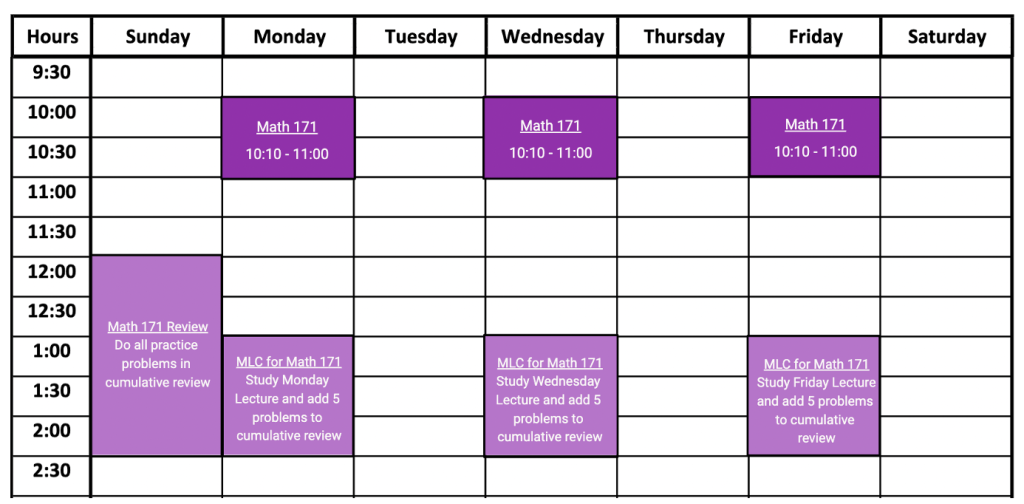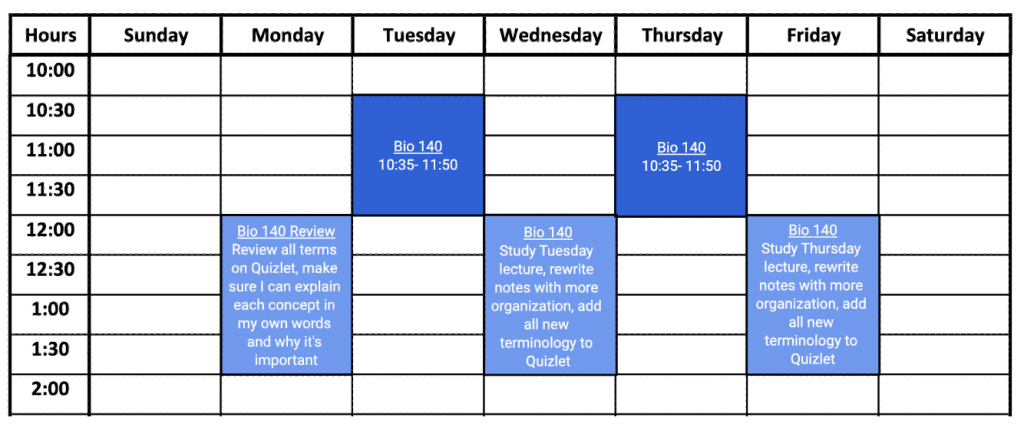The first thing you should know is that this recipe was derived from a bunch of scientific research about how the brain learns and develops memories, so this isn’t something random I made up. For the purposes of keeping this blog post nice and short, I’m not going to go into the details of why or how this recipe works, but if you want to learn more about the research behind the method, an academic coach would be happy to share it with you as well as many other effective strategies for learning and retaining new info! Now let’s get into it.
Step 1: Begin With a Generous Dose of Weekly Studying
Too many people hold the false belief that studying is something you’re supposed to do before an exam, not every day. We know from scientific research that this isn’t the way our brains learn or remember new info. We know that content needs to be “re-learned” outside of class, and content needs to be reviewed weekly for the brain to remember. Here’s what I recommend:
- Think about a class you want to start studying more for. As an example, let’s say we’re thinking about a MWF class. Now consider you have a test on just Monday’s lecture. How much time do you need to study for that one lecture? Have a number in mind? Let’s go with 1 hour for our hypothetical scenario. Now multiply that by how many times you have that class per week. This is how much time you should be studying per week for just this one class. For our example, we need 1 hour for Monday’s lecture, 1 hour for Wednesday’s lecture, and 1 hour for Friday’s lecture – so right now, we need to set aside 3 hours of studying time every week for this class.
Step 2: Spice it Up by Studying Effectively
From step 1, you should have a certain number of hours set aside in your weekly planner to study for your class. Now we need to think about how to use those hours. The keys to successful learning are active study strategies that require you to actually do something (simply re-reading notes doesn’t count) and understanding material on a deep level, not a surface one. Here are my recommendations:
- For math-heavy classes, you need to be able to solve practice problems without notes or assistance, and you should be able to explain each step of the problem and why you’re doing it. If you can’t solve the problems or if you don’t know why certain steps are done, use resources such as the textbook, online videos, tutoring, or professor office hours. You should get to the point where your can teach someone else how to solve the problems.
- For terminology-heavy classes, I recommend creating a Quizlet or flashcards to practice memorizing new terms. As you’re practicing memorization, you need to test your understanding by explaining each term, why it’s important, and how it relates to the other terms you’re learning. Your studying is not finished until you’ve memorized all new terms and understand their meanings on a deeper level.
- For diagram-heavy classes (such as anatomy), you need to be able to recreate all of the diagrams as you would be expected to on a test. I recommend printing out a blank diagram and practice filling it in until you know the entire diagram by heart. You should also know the meanings of each of the pieces labeled and how they all interact with each other.
- For reading-heavy classes, take the time to annotate the main ideas while you’re doing the readings. Your studying should then be ensuring that you fully understand and remember the main ideas from the text. Sometimes it’s helpful to create flashcards if there are a lot of things to memorize or write short summaries if the main ideas are somewhat lengthy. Writing a summary of something complex in your own easy-to-understand wording is a great way to improve both understanding and retention. I also recommend using online summaries to help you understand things and to make sure you don’t miss anything important. If you struggle with pin-pointing main ideas, go to tutoring or professor office hours for help until you’re able to do this on your own.
Step 3: Top It Off with Some Cumulative Study
Up until now, I’ve focused on how to study for individual lectures. For example, you attend a Monday lecture and then you spend an hour on Tuesday reviewing the content from that lecture and doing some practice problems. This is great for improving your understanding of content, but you need to see the material more frequently in order to remember it all for a test. This is why I recommend a weekly cumulative review in addition to your study blocks from steps 1 and 2. Here’s what I recommend:
- Create a location for you to store everything you need to know for an upcoming test. This can be a word document, a specific section of a notebook, a binder, etc. Every time you study lecture content in steps 1 and 2, add the materials to that document. If you’re studying math, choose a few practice problems that were hard and write them down. If you’re studying terminology, keep all of the flashcards in one location. If you’re studying diagramming, store the blank diagrams. If you’re doing reading, store all main ideas, authors, and summaries. Once a week, go back to this location and review all of the materials. So week 1, you’ll just be looking at week 1 content. Week 2, you’ll be reviewing weeks 1 and 2 together. Week 3, you’ll be reviewing weeks 1, 2, and 3 all together. This method ensures that you’re seeing the content regularly so you don’t forget anything. It also provides a study guide for the time of the test!
Step 4: Mix It Together and Add It to Your Planner
Now that you know how many hours you need to study per week and how you should be using that time, add it to your planner! I’ve included a few example below for what this could look like.
- M,W,F Math class

- Tu,Th Biology class


